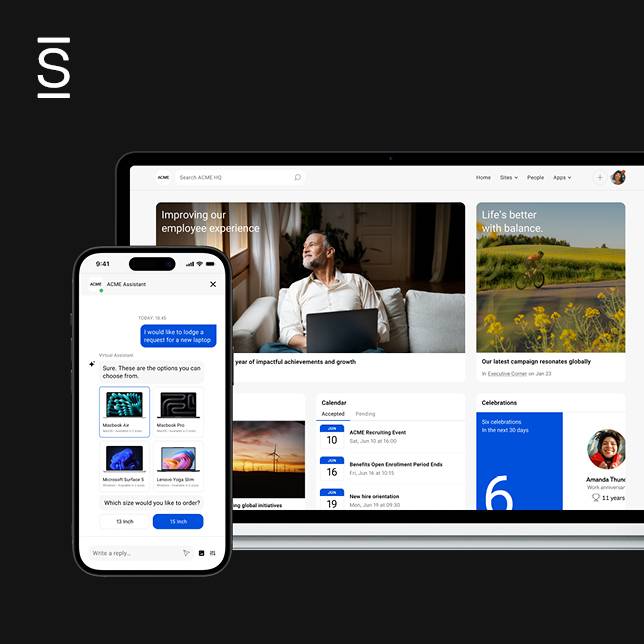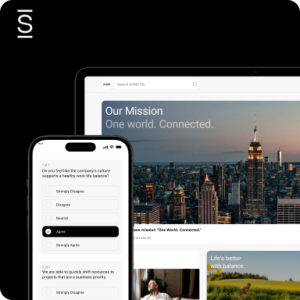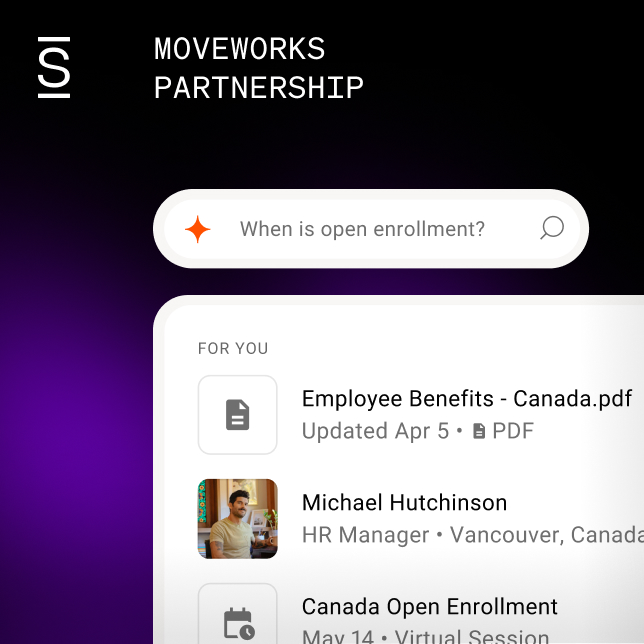What is a social intranet?
With the increased migration of workplaces to digital interfaces and cloud-based platforms comes the need for more effective collaboration and communication tools. This is essentially what is an intranet. The modern intranet is not just an employee experience platform, but it is also social. But what is the social intranet, and how can it benefit your organization? Let’s explore.
What is an intranet?
In simple terms, an intranet is a private network through which employees share information and knowledge, thereby improving internal communication and collaboration.
Elements of a social intranet:
A social intranet is an internal and private social network that facilitates the coordination of teams, greater alignment across organizations, and employee networking and communication.
A social intranet merges the features of an intranet and the benefits of social networks. They are built around people and help to humanize the workplace. The right social intranet will drive employee engagement and the benefits of collaboration.
Social intranets are essential in today’s work landscape, that’s remote and digital. With social media integrated into an organization’s work collaboration tool, employees would be more proactive and excited about their roles. This way, social intranets can minimize or eliminate the distractions that characterize remote or virtual teams.
Social intranet vs. traditional intranet
The traditional intranet provides all the tools that employees need to get work done. It helps employees and management find important files, and receive real-time updates on their tasks and company memoranda. The intranet essentially takes the physical office online.
Traditional intranets sometimes provide siloed content management systems, search capabilities, and collaboration sites. However, they miss out on the engagement feature.
Social intranets expand engagement and collaboration among staff and management through their authorship and connection features. With a traditional intranet, the concept of authorship is limited and restricted, providing editor permissions to only a handful of people. Social intranets go beyond this to engage all users in a massive way.
Social intranets allow for a higher level of interaction and participation by enabling everyone on the platform to author content and interact with content produced by others. Social intranets are internal-facing websites that allow employees to share knowledge and information and own what they share, thereby igniting fascinating interactions around work. The social intranet merges social with work. It provides robust features that make the workplace more exciting. With a social intranet, remote teams do not have to veer off into social networks. They get to be social on work collaboration tools and, therefore, more productive.
Benefits of the social intranet
Since traditional intranets mainly provide employees with read-only access to all the company resources on the platform, they make for a watered-down form of collaboration. Employees cannot get the best out of the intranet, and the disengagement that follows can lead to drops in productivity.
Social intranets allow employees to create their own content and engage with that of others by way of liking and commenting on them. In doing so, these kinds of intranets bring social network features to the work collaboration platform.
Let’s explore the core benefits of social intranets that your organization can harness today.
Improved communication
Social intranets enable a two-way communication system that includes employee-to-management and exchanges between employees. The ability to create content and trace all content to their respective authors helps improve how teams interact. Unlike traditional intranets that do not enable knowledge sharing, social intranets enhance internal communication across the whole organization.
Improved collaboration
Teams are now spread across countries, making collaboration in the workplace more important than ever but also a challenge for many organizations. As management tries to onboard the best talent, the geographical distance between employees widens, making it essential to prioritize collaborative measures. Intranets make it easy to do this. Social intranets take this further by providing collaboration tools that help employees connect more easily. These tools include status updates, activity streams, and instant messaging.
Increased productivity
Although intranets can keep your employees working on the same platform, traditional intranets come with their setbacks. With an intranet that does not allow employees to engage with shared information, there would still be the need to get in touch with team members for important updates, and as a result they will find disconnected and disorganized ways to do this.
If they cannot locate specific files, for example, they may have to place calls to other team members or track down information when it’s unclear who owns it.
A social intranet allows employees to ask questions and get answers immediately, boosting productivity and reducing interruptions from days to minutes. With private messaging and commenting features, a social intranet can boost productivity by enabling employees to engage with content in real-time and provide their own updates. In this way, they become better able to focus on their work priorities.
Better information management
Social intranets help management get employee feedback, which could then be used to enhance their work experiences. From accessing documentation to staying updated on company news, social intranets improve the information-sharing process within organizations.
The features of a social intranet also enhance employees’ access to information. Obtaining instructions and other forms of help with tasks is faster and more efficient when using a social intranet.
Employee engagement
Social intranets include features of social networks that drive employee engagement, such as status updates, liking, private messaging, and commenting. A Deloitte study found that employee engagement can increase retention by up to 87%, and social tools, when used internally, increase employee satisfaction by 20%. A social intranet drives connection and collaboration between employees, making them excited about their roles. In this way, social intranets drive employee engagement and deliver the work satisfaction that bonds teams.
Important social intranet features
While social intranets may differ by the tools they provide, here are some key features your intranet should have to better serve your needs.
Open publishing rights
This feature should be easy to use for everyone on your team. The intranet should allow them to add photos, articles, and updates without restrictions. The publishing feature will enhance communication and connection between all team members and add a face behind every content.
Commenting abilities
Social intranets bring the commenting features of social networks to intranets. They encourage social behavior between teams and allow for two-way communication that drives productivity in the long run.
Instant messaging
This essential feature of social intranets helps employees maintain focus and reduce interruptions. Through the instant messaging feature of social intranets, employees can instantly prioritize their tasks by obtaining the necessary information.
Activity streams/feeds
Social intranets provide feeds, just like social networks do. The feeds are short and active, allowing for live updates on happenings within the company. They are modeled after Twitter feeds but, in this case, are internal.
Recognition
This feature allows for a reward system with employees applauding one another. It also enables the organization to build a culture by showcasing the details of company values and allowing discussions about these values among all members of the organization.
Discussion forums
Social intranets can also have discussion forums where teams share ideas on their tasks. Leadership can also share information and seek feedback on the forums. Through this feature, the organization can quickly build a community on the most pressing topics that affect everyone.
Mobile access
By the nature of remote teams, not everyone would be as tech-savvy as the other. Some team members may not have access to the same tech tools as others. Some may prefer to complete tasks on mobile. As such, social intranets should be optimized for mobile. People should be able to access the intranet, collaborate and communicate regardless of the device they use to access it.
Integration with other tools
The best social intranets also allow for integration with other collaboration tools. Whatever tool makes your work easier, you should be able to bring these into your intranet for an even better experience.
Best Practices
Here are some best practices that can make your social intranet a success.
Make contribution easy
Enable the content publishing feature and commenting abilities so that employees can contribute their knowledge easily on the platform. Sharing information with other employees will provide everyone with a sense of community.
Invest in mobile-friendly
Make sure that your intranet works well on mobile devices. Not everyone can access the intranet from a desktop or personal computer. Regardless of what they use, every employee should get the same experience. Implement mobile UX techniques that make the intranet accessible on the go.
Define your goals
The best way to get your intranet suited to your needs is to define your goals. Instead of focusing on the features that you want your intranet to have, start with what you want it to achieve and then design your features around this.
Encourage active participation
It is easy for users to forget your intranet altogether. This is why you want to go for the social intranet, what we call the modern intranet at Simpplr. Still, you must encourage employees and leadership teams to participate actively on the intranet. You can encourage this active participation by announcing important information on the intranet and responding to feedback.
Monitor and manage content
Don’t just leave content that’s created on the intranet. You should monitor the flow of content and engagement levels. It also helps to set ground rules like social media networks do so that people are respectful and helpful with their content.
Conduct analytics
Similarly, you should carry out analytics and utilize this analytical data for an overall better employee experience on the intranet.
Regularly review and update
You should also conduct regular reviews as you collect analytical data from interactions over your organization’s intranet. Check that the social intranet has all the relevant features and is working correctly. You may need to add more features for an overall better experience. Whenever this is the case, you should update the intranet accordingly.
Social intranet and the digital workplace
Organizations are increasingly using team collaboration tools such as Slack, Discord, and Google Hangouts for social functions like private messaging. While many people feel this is the new way to bring social collaboration to the digital workplace, this is not the case from an internal communications perspective.
These channels are not designed for top-down communications. They often get too noisy and defeat the purpose of social collaboration within the digital workplace.
Our modern intranet at Simpplr has a Slack integration that works to make social collaboration possible and more efficient. It ensures collaboration and employee engagement through features drawn from social networks. And it merges these with its knowledge-sharing features. Social intranets play a crucial role in helping to create a more efficient and effective digital workplace.
Employees can show up at the digital workplace on a social intranet, stay engaged and helpful, and get work done without interruptions. In this way, social intranets are an effective alternative to the work coordination that happens in person in your office.
Putting social intranets to work: key functions
Social intranets can drive internal communications, enhance employee engagement, and boost collaboration. Businesses are transcending these primary functions of the social intranet and using them innovatively. Here are some you could try with your social intranet.
Employee recognition programs
A social intranet can incorporate your employee recognition program to boost the morale of your workforce. These programs increase employee satisfaction and can take many forms when integrated into your social intranet. Examples include formal programs like employee or team of the month, informal shout-outs among colleagues, or public thank you on the social intranet. These forms of recognition can significantly impact how employees view their work.
Employee profiles
Employees can share their profiles on the company’s social intranet. Doing this provides an avenue to build relationships as you can urge them to include personal information in their profiles. With employees scattered around the world, this can be invaluable as it provides perspective on which employees to merge on the same team for better collaboration. It also enhances the workplace experience as employees can quickly identify people with similar interests. Shared interests that employees could add to their profile include hiking, biking, scuba diving, and more.
Staff onboarding
Businesses also use the social intranet to onboard new staff. Getting remote workers into the team can be tricky as the methods for inducting them in physical offices will not work here. With creativity, leaders, staff, and new employees can enjoy the onboarding process. Organizations do this on the social intranet by creating an onboarding channel, pairing the new employee with a more experienced colleague, uploading how-to videos, online workflows, and other helpful information, and providing support as quickly as possible.
Instant messaging
Social intranets enhance the decision-making process. Businesses make faster decisions by using the instant messaging attribute of the social intranet. These include features like commenting abilities and private messaging. Instead of waiting long hours for key team members to provide files and next steps, leaders can meet them where they are and thus make quick decisions on all levels.
Conclusion
The social intranet is changing the way we work in the digital space. Since remote work has risen continually as a preferred method for work, engaging all employees and ensuring better team collaboration is extremely important. Yet, these are just a preview of what a social intranet can help your organization achieve.

Watch a 5-minute demo
See how the Simpplr employee experience platform connects, engages and empowers your workforce.
- #1 Leader in the Gartner Magic Quadrant™
- 90%+ Employee adoption rate
Related Resources:
- Understanding The Concept Of An Intranet
- Exploring The Uses Of An Extranet
- Understanding Corporate Intranet Platforms
- Best Practices For Driving Intranet Adoption
- Understanding The Importance Of Intranet Approaches
- Understanding The Corporate Social Intranet
- Understanding The Differences Between Intranet And Extranet
- Exploring The Best Intranet Platforms
- Understanding The Benefits Of An Intranet
- Exploring Features Of A Corporate Social Intranet










